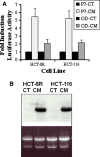Oct-1 cooperates with the TATA binding initiation complex to control rapid transcription of human iNOS
- PMID: 22349263
- PMCID: PMC11114494
- DOI: 10.1007/s00018-012-0939-z
Oct-1 cooperates with the TATA binding initiation complex to control rapid transcription of human iNOS
Abstract
Expression of the human inducible nitric oxide synthase (hiNOS) is generally undetectable in resting cells, but stimulation by a variety of signals including cytokines induces transcription in most cell types. The tight transcriptional regulation of the enzyme is a complex mechanism many aspects of which remain unknown. Here, we describe an octamer (Oct) element in hiNOS proximal promoter, located close to the TATA box. This site constitutively binds Oct-1 and its deletion abrogates cytokine-induced transcription, showing that it is indispensable though not sufficient for transcription. Increasing the distance between Oct and the TATA box by inserting inert DNA sequence inhibits transcription, and footprinting of this region shows no other protein binding in resting cells, suggesting an interaction between the two complexes. Chromatin immunoprecipitation assays detect the presence of Oct-1, RNA polymerase II and trimethyl K4 histone H3 on the proximal promoter in resting cells, confirming that the gene is primed for transcription before stimulation. RT-PCR of various fragments along the hiNOS gene shows that transcription is initiated in resting cells and this is inhibited by interference with Oct-1 binding to the proximal site of the promoter. We propose that, through interaction with the initiation complex, Oct-1 regulates hiNOS transcription by priming the gene for the rapid response required in an immune response.
Figures







Similar articles
-
Oct-2 forms a complex with Oct-1 on the iNOS promoter and represses transcription by interfering with recruitment of RNA PolII by Oct-1.Nucleic Acids Res. 2015 Nov 16;43(20):9757-65. doi: 10.1093/nar/gkv829. Epub 2015 Aug 13. Nucleic Acids Res. 2015. PMID: 26271992 Free PMC article.
-
A far-upstream Oct-1 motif regulates cytokine-induced transcription of the human inducible nitric oxide synthase gene.J Mol Biol. 2009 Jul 24;390(4):595-603. doi: 10.1016/j.jmb.2009.05.036. Epub 2009 May 23. J Mol Biol. 2009. PMID: 19467240 Free PMC article.
-
Interaction of Oct-1 with TFIIB. Implications for a novel response elicited through the proximal octamer site of the lipoprotein lipase promoter.J Biol Chem. 1995 Aug 18;270(33):19613-23. doi: 10.1074/jbc.270.33.19613. J Biol Chem. 1995. PMID: 7642649
-
Complex regulation of human inducible nitric oxide synthase gene transcription by Stat 1 and NF-kappa B.Proc Natl Acad Sci U S A. 2001 Jul 17;98(15):8638-43. doi: 10.1073/pnas.151239498. Epub 2001 Jul 3. Proc Natl Acad Sci U S A. 2001. PMID: 11438703 Free PMC article.
-
Oct-1, to go or not to go? That is the PolII question.Biochim Biophys Acta. 2016 Jun;1859(6):820-4. doi: 10.1016/j.bbagrm.2016.04.003. Epub 2016 Apr 7. Biochim Biophys Acta. 2016. PMID: 27063953 Review.
Cited by
-
miR-548d-3p Alters Parasite Growth and Inflammation in Leishmania (Viannia) braziliensis Infection.Front Cell Infect Microbiol. 2021 Jun 10;11:687647. doi: 10.3389/fcimb.2021.687647. eCollection 2021. Front Cell Infect Microbiol. 2021. PMID: 34178725 Free PMC article.
-
Leishmania (Leishmania) amazonensis induces macrophage miR-294 and miR-721 expression and modulates infection by targeting NOS2 and L-arginine metabolism.Sci Rep. 2017 Mar 9;7:44141. doi: 10.1038/srep44141. Sci Rep. 2017. PMID: 28276497 Free PMC article.
-
Tailoring the models of transcription.Int J Mol Sci. 2013 Apr 8;14(4):7583-97. doi: 10.3390/ijms14047583. Int J Mol Sci. 2013. PMID: 23567272 Free PMC article. Review.
-
Oct-2 forms a complex with Oct-1 on the iNOS promoter and represses transcription by interfering with recruitment of RNA PolII by Oct-1.Nucleic Acids Res. 2015 Nov 16;43(20):9757-65. doi: 10.1093/nar/gkv829. Epub 2015 Aug 13. Nucleic Acids Res. 2015. PMID: 26271992 Free PMC article.
-
The Oct1 transcription factor and epithelial malignancies: Old protein learns new tricks.Biochim Biophys Acta. 2016 Jun;1859(6):792-804. doi: 10.1016/j.bbagrm.2016.02.007. Epub 2016 Feb 10. Biochim Biophys Acta. 2016. PMID: 26877236 Free PMC article. Review.
References
-
- de Vera ME, Shapiro RA, Nussler AK, Mudgett JS, Simmons RL, Morris SM, Jr, Billiar TR, Geller DA. Transcriptional regulation of human inducible nitric oxide synthase (NOS2) gene by cytokines: initial analysis of the human NOS2 promoter. Proc Natl Acad Sci USA. 1996;93(3):1054–1059. doi: 10.1073/pnas.93.3.1054. - DOI - PMC - PubMed
Publication types
MeSH terms
Substances
LinkOut - more resources
Full Text Sources

